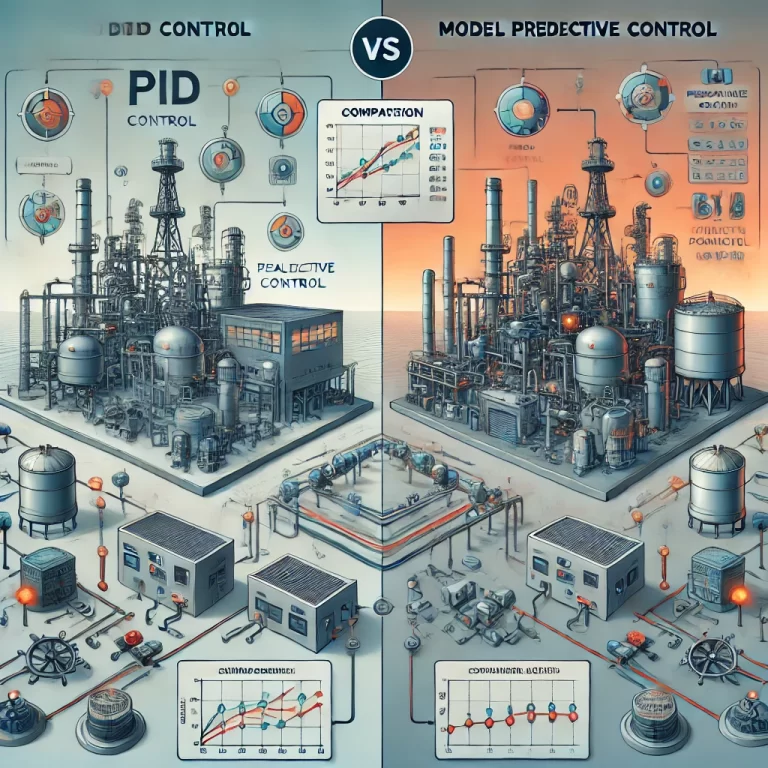1. Define Control Objectives
Before touching parameters, agree on measurable targets for the loop: setpoint tracking speed, allowable overshoot, steady‑state error, disturbance rejection, and noise sensitivity. Capture hard constraints (actuator limits, safety margins) and the plant’s operating range.

2. Choose Initial Parameters
Pick safe starting values based on prior experience or vendor guidelines. If unknown, start conservative: Kp small, Ki = 0, Kd = 0. Ensure the controller direction (direct/reverse) matches the process.
3. P‑Only Pass
Set Ki = 0, Kd = 0. Increase Kp until the loop responds briskly but remains non‑oscillatory under small setpoint steps and typical disturbances. If sustained oscillation appears, back Kp off by ~20–30%.

4. Add Integral (PI)
Increase Ki gradually to eliminate steady‑state error. Watch for slower decay or emerging oscillations. If the loop starts to hunt, reduce Ki or slightly increase Kp. Use anti‑windup (integrator clamping or back‑calculation) when actuators saturate.
5. Add Derivative (PID)
Introduce Kd to damp overshoot and tame oscillations. Filter the derivative term (e.g., first‑order filter with 1–10% of the dominant time constant) to reduce noise amplification. Avoid excessive Kd which can slow response and amplify measurement noise.
6. Parameter Refinement
Iteratively fine‑tune Kp, Ki, Kd to meet objectives. If available, apply formal methods (e.g., relay test for ultimate gain/period, Ziegler–Nichols, IMC). Validate at multiple operating points and with realistic disturbances.
7. Test & Validate
Run acceptance tests: step changes, load disturbances, and noise scenarios. Verify rise time, settling time, overshoot, IAE/ITAE, control effort, and actuator saturation behavior. Document final settings and known limits.

Quick On‑Site Procedure (5–Step)
- Set Ki = 0 and Kd = 0. Increase Kp until just below the onset of sustained oscillation.
- Add Ki until the steady‑state error disappears within the target settling time; enable anti‑windup.
- Add modest Kd to reduce overshoot and oscillations; apply derivative filtering.
- Re‑balance: small increases of Kp after adding Ki and Kd often restore crispness.
- Stress test with realistic disturbances and confirm actuator never sticks at limits.
Common Symptoms → Likely Adjustments
Observed Symptom | Likely Cause | Try This First |
Slow response / sluggish tracking | Kp too low; Ki too low | Increase Kp; then increase Ki |
Large steady‑state error | Insufficient integral action | Increase Ki (with anti‑windup) |
Overshoot / ringing | Kp too high; Ki too aggressive | Reduce Kp or Ki; add/increase Kd |
Sustained oscillation | Loop near/over ultimate gain | Reduce Kp; reduce Ki; add Kd |
Noisy control output | Derivative amplifying noise | Lower Kd; increase D filter; check sensor |
Integrator windup (long recovery after saturation) | No anti‑windup | Enable clamping/back‑calculation; reduce Ki |
Actuator chattering / excessive control effort | Too aggressive gains or noise | Lower Kp/Kd; add output rate limit or filter |
Good setpoint tracking but poor disturbance rejection | Insufficient Kp or Ki | Increase Kp and/or Ki; consider feedforward |

Practical Notes
- Always confirm the actuator and measurement polarity (reverse vs. direct acting).
- Separate filtering: apply to PV (measurement) and use a modest derivative filter; avoid over‑filtering that adds lag.
- If process is integrating (e.g., level), start with lower Ki to avoid runaway.
- For time‑delay dominant plants, target slower closed‑loop bandwidth (don’t chase dead‑time). Consider a Smith predictor if needed.
- Log trends during tuning; evaluate settling time, overshoot, and control effort rather than relying on a single step test.
- Record final Kp, Ki, Kd, filter constants, and sampling time in the handover sheet.

Commissioning Checklist
☐ Controller direction verified (reverse/direct).
☐ Actuator limits and rate limits set; anti‑windup enabled.
☐ Initial P‑only test completed; ultimate gain avoided.
☐ Integral added and steady‑state error eliminated.
☐ Derivative added and filtered; noise acceptable.
☐ Performance criteria met across operating range.
☐ Documentation updated and archived.
